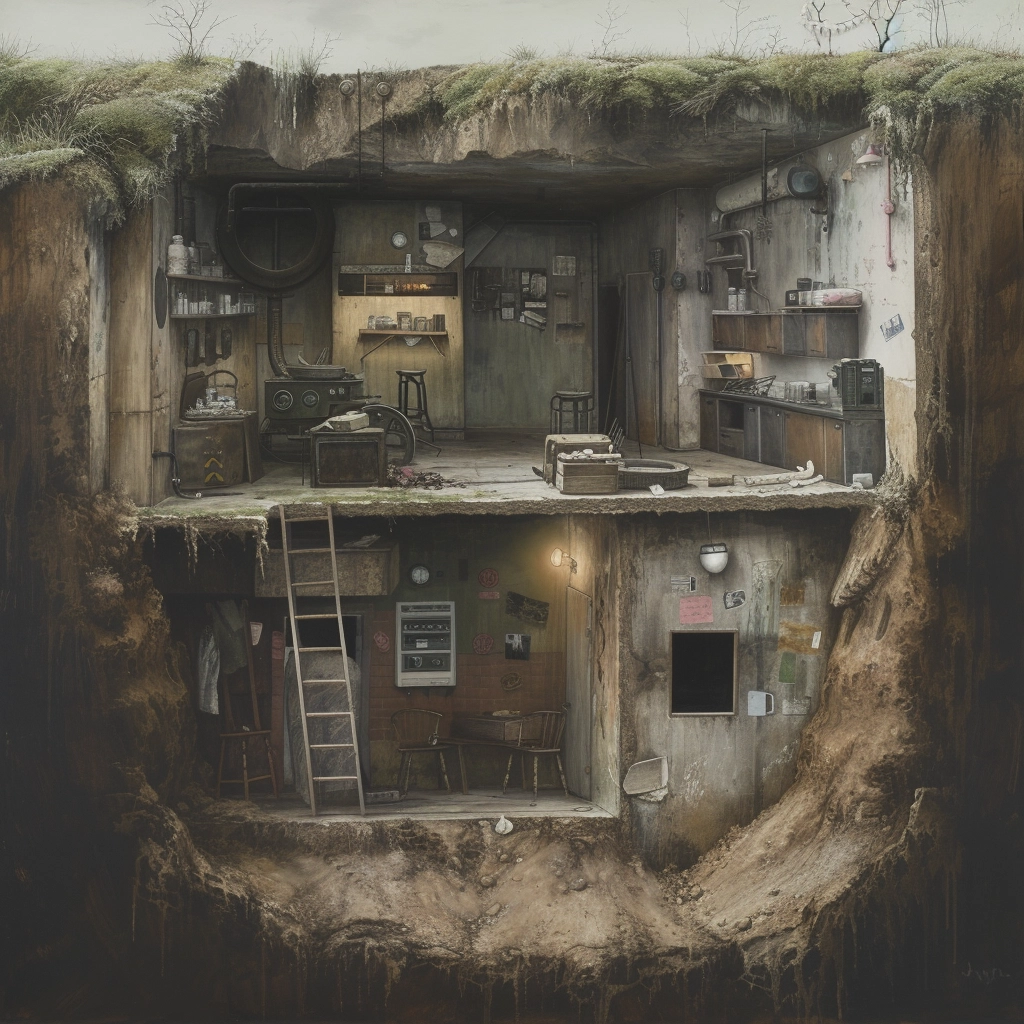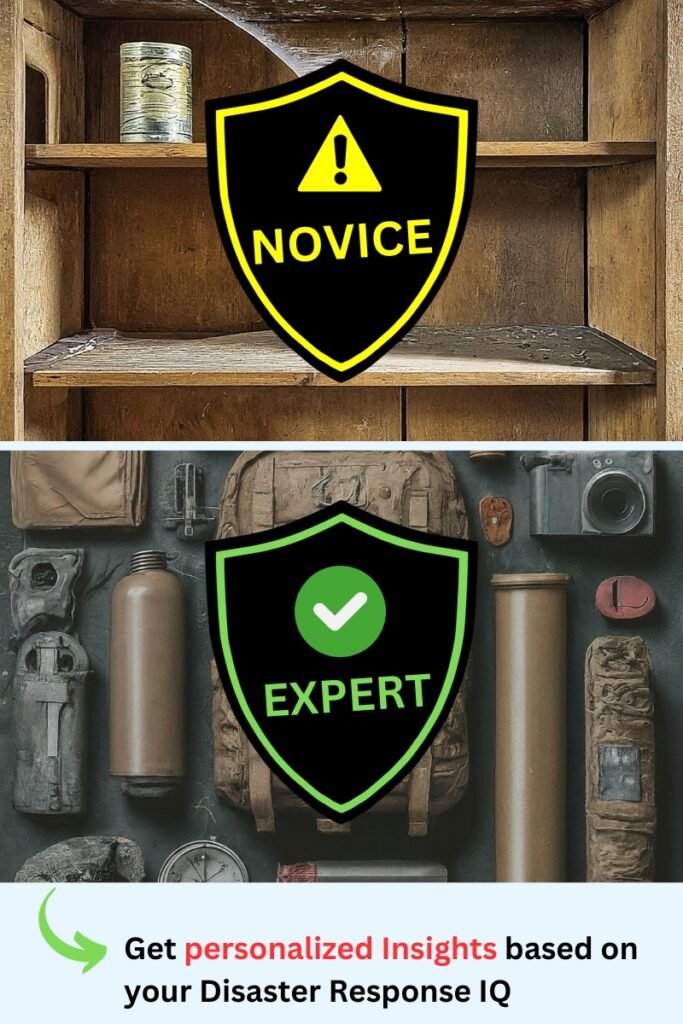During the tense days of the Cuban Missile Crisis in October 1962, the threat of nuclear war between the United States and the Soviet Union was alarmingly real.
As the two superpowers stood on the brink of conflict, many Americans took extraordinary measures to prepare for the possibility of a nuclear attack.
Among these measures was the construction of fallout shelters – underground bunkers designed to protect against the harmful effects of nuclear fallout and radiation.
In this article, you will learn how preppers during the Cuban Missile Crisis prepared fallout shelters to protect against the threat of nuclear war, including the key design elements, supplies needed, psychological preparedness required, and lessons that can be applied to modern emergency preparedness efforts.
Table of Contents
The Cuban Missile Crisis and the Rise of Prepper Culture

The Cuban Missile Crisis was a pivotal moment in Cold War history, when the United States and the Soviet Union came perilously close to engaging in nuclear warfare.
The crisis was sparked by the discovery of Soviet nuclear missiles being installed in Cuba, just 90 miles from the American mainland.
For 13 tense days, the world held its breath as the two superpowers engaged in a high-stakes game of diplomatic brinkmanship. The fear of a nuclear exchange was palpable, and many Americans found themselves gripped by a sense of dread and uncertainty.
It was in this climate of fear and anxiety that the “prepper” mindset took root.
Driven by a desire for self-reliance and a determination to survive even the most catastrophic scenarios, many Americans began to take measures to prepare for the worst.
Families stockpiled food, water, and other essential supplies.
QUIZ: What's Your Disaster Response IQ?
Think you're beyond novice level? Start the quiz to know for sure.
Communities organized emergency response plans.
And throughout the country, people began constructing their own fallout shelters – underground bunkers designed to protect against the devastating effects of nuclear fallout.
Understanding Nuclear Fallout and Radiation

To fully appreciate the importance of fallout shelters during the Cuban Missile Crisis, it is essential to understand the nature of nuclear fallout and the dangers it poses.
Nuclear fallout is the radioactive debris and particles that are released into the atmosphere following a nuclear explosion.
This debris can be carried by wind currents and spread over vast areas, posing a significant threat to human health and the environment.
Exposure to nuclear radiation can have severe and long-lasting consequences, including:
- Acute Radiation Syndrome (ARS): High doses of radiation can cause nausea, vomiting, hair loss, and even death in extreme cases.
- Increased Cancer Risk: Radiation exposure can damage DNA and increase the risk of developing various types of cancer.
- Genetic Mutations: Radiation can cause genetic mutations that can be passed down to future generations.
To mitigate these risks, proper radiation shielding and protection are crucial.
This is where fallout shelters come into play, providing a safe haven from the harmful effects of nuclear fallout.
The Basics of Fallout Shelter Design

Designing an effective fallout shelter requires careful consideration of several key elements. Here are some of the essential components:
Location: Fallout shelters should be located underground or in basements, as this provides natural shielding from radiation.
The shelter should also be situated away from potential targets or areas that could be affected by blast waves.
Structure: The shelter’s structure must be robust and able to withstand the pressure and debris that could result from a nuclear explosion. Reinforced concrete or earth-covered shelters are common choices.
Radiation Shielding: Adequate shielding is crucial to protect occupants from radiation. The thickness of the shielding material (concrete, earth, etc.) must be calculated based on the anticipated radiation levels.
Ventilation: Proper ventilation is essential to maintain a safe and breathable environment within the shelter. Air filtration systems should be designed to remove radioactive particles and other contaminants.
Emergency Supplies: Fallout shelters should be stocked with essential supplies, including food, water, medical supplies, and other necessities for survival during an extended stay.
Radiation Shielding Materials and Techniques
Choosing the right materials and implementing proper shielding techniques are critical for protecting against radiation in a fallout shelter.
Here are some common materials and methods used for radiation shielding:
- Concrete: Concrete is a popular choice for shielding due to its high density and ability to absorb radiation. The thickness required depends on the anticipated radiation levels.
- Earth/Soil: Covering a shelter with several feet of densely packed earth or soil can provide effective shielding against radiation.
- Lead: While expensive, lead is an excellent radiation shield due to its high density and ability to absorb gamma rays.
- Water: Water tanks or containers can be used as supplementary shielding, as water is an effective absorber of radiation.
When designing a fallout shelter, it is crucial to consider not only the shielding materials but also the overall layout and potential entry points for radiation.
Proper sealing and shielding of doors, ventilation systems, and other openings is essential to ensure maximum protection.
Ventilation and Air Filtration Systems
While providing essential radiation shielding, fallout shelters must also address the critical issue of ventilation and air quality.
Prolonged confinement in an enclosed space can quickly lead to a buildup of carbon dioxide, moisture, and other contaminants, making the environment hazardous to occupants.
To maintain a safe and breathable atmosphere, fallout shelters typically incorporate specialized ventilation and air filtration systems.
These systems serve to:
- Introduce Fresh Air: Fans or blowers are used to draw in fresh air from the outside while expelling stale air from the shelter.
- Filter Contaminants: High-efficiency particulate air (HEPA) filters or other specialized filters are employed to remove radioactive particles, dust, and other harmful contaminants from the incoming air.
- Maintain Proper Air Flow: Proper air circulation and distribution throughout the shelter are essential to ensure adequate ventilation and prevent the buildup of stale or contaminated air pockets.
In addition to ventilation systems, fallout shelters may also incorporate other air quality measures, such as dehumidifiers to control moisture levels and scrubbers to remove harmful gases or vapors.
Fallout Shelter Supplies and Stockpiling
Adequate supplies and provisions are essential for surviving an extended stay in a fallout shelter.
During the Cuban Missile Crisis, preppers had to carefully plan and stockpile the necessary supplies to sustain themselves and their families in the event of a nuclear attack.
Here are some of the critical supplies that should be considered for a fallout shelter:
| Supply Category | Examples |
|---|---|
| Food and Water | Non-perishable food items, water purification tablets, containers for water storage |
| Medical Supplies | First aid kits, essential medications, radiation detection equipment |
| Sanitation | Toilet facilities, personal hygiene items, waste disposal systems |
| Power and Lighting | Batteries, flashlights, portable generators, fuel |
| Communication | Radios, emergency signaling devices |
| Tools and Equipment | Tools for shelter maintenance, cooking supplies, bedding |
When stockpiling supplies, it is crucial to consider the anticipated duration of the shelter stay and the number of occupants.
Calculating the required quantities and ensuring proper storage and rotation of perishable items are essential steps in preparing an adequate supply stockpile.
Psychological Preparedness and Community Support

While the physical aspects of fallout shelter preparation are crucial, it is equally important to consider the psychological and emotional toll of living in such confined and stressful conditions.
The prospect of being confined underground for an extended period, potentially in the aftermath of a nuclear attack, can be an immense psychological burden.
To mitigate the mental and emotional strain, preppers during the Cuban Missile Crisis had to develop coping strategies and foster a sense of community support.
Here are some key considerations:
- Psychological Resilience: Activities such as meditation, journaling, and stress management techniques can help individuals maintain emotional stability and mental fortitude.
- Family and Social Support: Having a strong support system of family and friends within the shelter can provide comfort and a sense of community during difficult times.
- Mutual Aid and Cooperation: Establishing clear roles, responsibilities, and a system of mutual aid within the shelter community can foster a sense of purpose and camaraderie.
- Entertainment and Distractions: Engaging activities, such as books, games, and educational materials, can help alleviate boredom and provide mental stimulation.
By addressing psychological preparedness and fostering a supportive community environment, preppers during the Cuban Missile Crisis aimed to ensure not only physical survival but also mental and emotional well-being in the face of adversity.
Learning from the Past: Lessons from Cuban Missile Crisis Preppers
The experiences of those who prepared fallout shelters during the Cuban Missile Crisis offer valuable lessons that can inform modern-day emergency preparedness efforts.
By examining what worked and what didn’t, we can gain insights into effective shelter design, supply stockpiling, and psychological resilience.
Here are some key lessons learned from the firsthand accounts of Cuban Missile Crisis preppers:
- Thorough Planning and Preparation: Meticulous planning and attention to detail were crucial in ensuring the effectiveness of fallout shelters. Preppers who took the time to carefully design their shelters, calculate radiation shielding requirements, and stockpile adequate supplies were better positioned for survival.
- Redundancy and Backup Systems: Having redundant systems and backup plans in place proved invaluable. Shelters with multiple ventilation systems, alternative power sources, and contingency plans for supply shortages or system failures were more resilient.
- Community Cooperation: Preppers who worked together with their neighbors and communities were better able to pool resources, share knowledge, and provide mutual support. A strong sense of community and cooperation fostered a more effective preparedness effort.
- Mental and Emotional Preparedness: The psychological toll of living in confined spaces and the stress of a potential nuclear attack were significant challenges. Preppers who prioritized mental health and emotional support mechanisms, such as group activities and counseling, were better equipped to handle the strain.
- Adaptability and Flexibility: Unforeseen circumstances and changing conditions required preppers to be adaptable and flexible in their approach. Those who were able to adjust their plans and improvise solutions as needed were better positioned to overcome obstacles.
- Documentation and Knowledge Sharing: Keeping detailed records and sharing experiences and lessons learned with others proved invaluable. This knowledge transfer helped refine preparedness strategies and informed future generations of preppers.
By learning from the successes and challenges faced by Cuban Missile Crisis preppers, we can better prepare for future emergencies and disasters.
Their experiences serve as a reminder of the importance of thorough planning, community cooperation, psychological resilience, and the ability to adapt to changing circumstances.
Fallout Shelter Safety and Maintenance
Building a fallout shelter is only the first step; ensuring its long-term safety and functionality requires diligent maintenance and upkeep.
During the Cuban Missile Crisis, preppers had to carefully consider the measures necessary to maintain their shelters’ structural integrity and essential systems.
- Structural Inspections: Regular inspections of the shelter’s structural components, such as walls, ceilings, and support beams, are essential to identify and address any potential issues or weaknesses.
- Ventilation System Maintenance: Air filtration systems, fans, and ducting must be regularly cleaned and serviced to ensure proper air flow and filtration efficiency.
- Supply Rotation and Replenishment: Perishable supplies, such as food and water, must be rotated and replenished regularly to maintain a viable stockpile.
- Emergency Plans and Drills: Developing and practicing emergency plans, including evacuation procedures, can help ensure preparedness in case of unforeseen events or system failures within the shelter.
- Documentation and Record-Keeping: Maintaining detailed records of shelter maintenance, supply inventories, and any incidents or issues can aid in identifying trends and making informed decisions about future improvements or modifications.
By implementing a comprehensive maintenance and safety plan, preppers during the Cuban Missile Crisis aimed to ensure that their fallout shelters remained a reliable and secure refuge in the face of potential nuclear threats.
The Future of Fallout Shelters and Emergency Preparedness
While the Cuban Missile Crisis may have passed, the need for emergency preparedness and resilience remains as relevant as ever.
As the world faces new and evolving threats, from climate change to geopolitical instability, the lessons learned from historic preppers can inform and guide our approach to modern-day preparedness efforts.
- Evolving Threat Landscape: While the specter of nuclear war may have diminished, other potential disasters, such as natural disasters, pandemics, and cyber attacks, highlight the importance of being prepared for a wide range of scenarios.
- Modern Shelter Technologies: Advancements in construction materials, ventilation systems, and renewable energy sources offer opportunities to design more efficient and sustainable fallout shelters.
- Community Resilience: Building resilient communities that can support one another and pool resources during emergencies can be a powerful component of preparedness efforts.
- Education and Awareness: Promoting emergency preparedness education and raising awareness about the importance of being self-sufficient can foster a culture of resilience and self-reliance.
By learning from the experiences of Cuban Missile Crisis preppers and embracing new technologies and approaches, we can continue to evolve our emergency preparedness strategies, ensuring that we are better equipped to face the challenges of an uncertain future.
Conclusion
In conclusion, the Cuban Missile Crisis stands as a powerful reminder of the importance of being prepared for even the most unthinkable scenarios.
The experiences of those who constructed fallout shelters during that tense period offer valuable insights into the design, construction, and maintenance of these vital survival structures.
By understanding the principles of radiation shielding, ventilation, supply stockpiling, and psychological preparedness, we can better equip ourselves to navigate future crises and emergencies.
As we look to the future, embracing new technologies and fostering a culture of resilience and self-reliance will be crucial in ensuring that we are prepared for whatever challenges may come our way.



